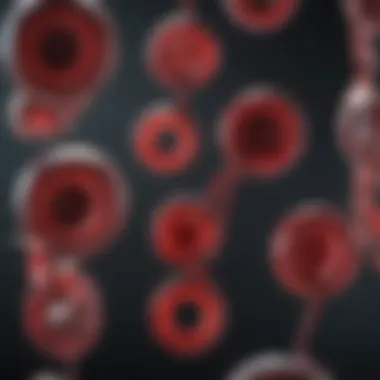Understanding Sickle Cell Disease: A Blood Disorder Overview


Intro
Sickle cell disease is a significant health concern affecting millions of individuals globally. It is primarily characterized by the presence of abnormal hemoglobin, known as hemoglobin S, in red blood cells. This genetic disorder results in misshapen cells that can lead to various health complications. Understanding sickle cell disease goes beyond just the medical implications; it also reveals important social, economic, and psychological aspects that affect the lives of those living with the condition.
This article will delve into the essential components of sickle cell disease, exploring its definition, genetic basis, symptoms, diagnosis, treatment options, and the socio-economic context surrounding it. Through this overview, readers will gain a comprehensive understanding of sickle cell disease and its impacts on individuals and communities.
Key Concepts
Definition of Primary Terms
Sickle cell disease (SCD) is a group of inherited blood disorders primarily affecting hemoglobin, a protein in red blood cells responsible for oxygen transport. When a person inherits two copies of the sickle cell gene, one from each parent, they develop sickle cell anemia, the most severe form of the disease.
Other important terms include:
- Hemoglobin S: The abnormal form of hemoglobin that causes red blood cells to become rigid and sickle-shaped.
- Sickle-shaped cells: These deformed cells can block blood flow in small vessels, leading to pain and other complications.
- Vaso-occlusive crisis: A painful event caused by the blockage of blood vessels due to sickle-shaped cells.
Related Concepts and Theories
Understanding sickle cell disease also involves familiarity with certain genetic principles. SCD follows an autosomal recessive inheritance pattern, meaning a child must inherit two copies of the sickle cell gene to express the disease. A carrier of one sickle cell gene (sickle cell trait) typically does not show symptoms but can pass the gene to offspring.
Several related concepts enhance this understanding:
- Genetic counseling: Important for families at risk, informing them about inheritance risks.
- Hemoglobin electrophoresis: A laboratory method to detect and analyze different types of hemoglobin in the blood.
- Transfusion therapy: A treatment option that may alleviate complications by introducing healthy red blood cells into the patient’s system.
"Sickle cell disease is not just a health issue; it is also a socio-economic challenge that requires comprehensive strategies for management and care."
Future Directions
Gaps Identified in Current Research
Despite advancements, gaps remain in the understanding and treatment of sickle cell disease. Research continues to identify better management strategies, especially in low-resource settings where healthcare access is limited. Issues include insufficient knowledge about pain management techniques and a lack of effective treatments for complications.
Suggestions for Further Studies
Future studies should explore:
- Improved screening methods to identify sickle cell trait at birth.
- Longitudinal studies that track the outcomes of patients over time.
- Psychosocial interventions to assist patients in managing the emotional burden of living with sickle cell disease.
Engagement with broader research communities could foster innovations in treatment and improve quality of life for those impacted by sickle cell disease.
What is Sickle Cell Disease?
Sickle cell disease represents a significant health concern, affecting millions globally. Understanding this disorder is crucial for various reasons. Firstly, it underscores the complexities of genetic diseases and their impact on people's lives. Sickle cell disease is not just a medical condition; it intertwines with social, economic, and psychological dimensions that require a holistic approach for effective management.
Definition and Classification
Sickle cell disease is defined as a group of inherited red blood cell disorders. The primary characteristic is the presence of abnormal hemoglobin, known as hemoglobin S. Under low oxygen conditions, hemoglobin S can cause red blood cells to deform into a sickle or crescent shape. This abnormal shape leads to numerous complications such as blockages in small blood vessels and overall decreased blood flow.
The classification of sickle cell disease can be detailed as follows:
- Sickle Cell Anemia (HbSS): The most severe form, where both hemoglobin genes inherited from parents are abnormal.
- Sickle Hemoglobin-C Disease (HbSC): A less severe form, resulting from inheriting one sickle cell gene and one gene for hemoglobin C.
- Sickle Beta-Thalassemia: Results from one sickle cell gene and one beta-thalassemia gene, leading to variable severity.
Understanding these classifications helps in tailoring management and treatment strategies effectively.
Epidemiology and Prevalence
The prevalence of sickle cell disease varies significantly across the globe. It is most common among individuals of African, Mediterranean, Middle Eastern, and Indian descent. According to estimates, approximately 300,000 babies are born each year with sickle cell disease. In the United States, about 100,000 people live with this disorder.
Several factors contribute to the epidemiological landscape:


- Geographic Distribution: It is most prevalent in sub-Saharan Africa, where malaria is endemic.
- Genetic Selection: Carriers of sickle cell trait (individuals with one sickle cell gene) have a survival advantage against malaria, explaining higher frequency in certain regions.
This geographical context illustrates the adaptive nature of genetic traits under specific environmental pressures.
The Genetic Basis of Sickle Cell Disease
The genetic basis of sickle cell disease is fundamental to understanding its mechanisms and implications. This blood disorder arises from a mutation in the HBB gene, which encodes the beta-globin subunit of hemoglobin. The understanding of this genetic framework informs both clinical practices and ongoing research into future therapies.
Sickle cell disease is not just a medical condition; it is a genetic inheritance that influences many aspects of life for affected individuals. Knowing the genetics helps in identifying at-risk populations and guides counseling for families.
Inheritance Patterns
Sickle cell disease follows an autosomal recessive inheritance pattern. This means that an individual must inherit two copies of the mutated gene, one from each parent, to have the disease. If a person inherits only one copy, they are carriers (known as having sickle cell trait), and usually do not show symptoms.
- Carrier Parents: If both parents are carriers, there is a 25% chance with each pregnancy that the child will have sickle cell disease, a 50% chance the child will be a carrier, and a 25% chance the child will be unaffected.
- Health Implications: Understanding these patterns is crucial for genetic counseling and managing family planning.
Pathophysiology of Sickle Hemoglobin
The pathophysiology of sickle hemoglobin is central to the disease's manifestations. The mutation in the beta-globin chain leads to the production of hemoglobin S instead of the normal hemoglobin A. Under low oxygen conditions, hemoglobin S polymerizes, causing red blood cells to become rigid and assume a crescent or sickle shape.
This sickling of red blood cells leads to numerous complications, such as:
- Blockage of Blood Vessels: The distorted cells can obstruct small blood vessels, which leads to pain and tissue damage.
- Hemolysis: Sickle cells have a shorter lifespan, leading to hemolytic anemia. The body struggles to replace these cells, creating additional health challenges.
- Increased Risk for Infections: Individuals with sickle cell disease are at a higher risk for certain infections due to spleen dysfunction.
The understanding of sickle hemoglobin and its effects on the body is critical for developing targeted treatments.
In summary, grasping the genetic underpinnings gives insight into how sickle cell disease affects individuals and informs treatment protocols. Continued research in this area is essential for improving patient care and outcomes.
Clinical Manifestations
Understanding the clinical manifestations of sickle cell disease is pivotal in comprehending the ailment's overall impact on individuals. These manifestations stem from the maladaptive behavior of sickle-shaped red blood cells, leading to various symptoms and complications. Recognizing these signs helps in timely interventions, improving patient outcomes, and informing treatment strategies.
Symptoms and Complications
Acute Pain Crises
Acute pain crises are a hallmark feature of sickle cell disease. These crises occur when sickle-shaped cells obstruct blood flow, causing intense pain in the affected areas. Pain often appears suddenly and can last for several hours or days. Understanding acute pain evidence can help patients manage their symptoms effectively.
- Key characteristic: The unpredictable and severe nature of these crises.
- Why it is beneficial: Addressing acute pain is crucial for improving the quality of life for patients.
- Unique feature: Crises can affect any body part, making it challenging to predict and prepare for.
The advantages of correctly identifying and treating acute pain crises can significantly reduce hospital visits and enhance the patient's comfort.
Chronic Pain
Chronic pain in sickle cell disease usually stems from ongoing damage caused by repeated pain crises and organ damage. This chronic pain affects daily living and mental health. Patients may feel exhausted and frustrated due to the enduring nature of their discomfort.
- Key characteristic: Continuous pain that can be both physically and emotionally taxing.
- Why it is beneficial: Recognizing chronic pain allows for ongoing management strategies.
- Unique feature: It varies in intensity and location, making it hard to treat universally.
Managing chronic pain is vital for overall well-being and aids in maintaining productivity.
Organ Damage
Sickle cell disease can lead to significant organ damage over time. The repeated episodes of blood vessel blockage can deprive organs of oxygen, leading to complications like splenic sequestration or acute chest syndrome. Patients may suffer from a range of symptoms as their organs gradually lose function.
- Key characteristic: Progressive impact on organ function, leading to long-term complications.
- Why it is beneficial: Awareness of potential organ damage assists in preventive care strategies and monitoring.
- Unique feature: Damage can occur unnoticed until critical systems fail, causing emergency situations.
Addressing organ damage is pivotal for preventing severe health complications and improving patient longevity.
Diagnosis of Sickle Cell Disease
Diagnosing sickle cell disease accurately is essential in tailoring treatment and managing symptoms effectively. Various tests can identify the disease's presence; each plays a role in ensuring prompt attention and intervention.


Blood Tests
Blood tests are fundamental in diagnosing sickle cell disease. They can reveal the presence of hemoglobin S, the aberrant form of hemoglobin responsible for sickling. Understanding the test results can clarify the disease's severity and treatment decisions.
- Key characteristic: Simple, minimally invasive blood draw.
- Why it is beneficial: Provides swift documentation of the disease status.
- Unique feature: Results can also indicate other potential blood disorders, offering a comprehensive view of the patient’s health.
The advantage is clear: rapid diagnosis leads to immediate action in managing the condition properly.
Newborn Screening
Newborn screening programs are excellent at identifying sickle cell disease early in life. By testing within the first few days after birth, healthcare providers can initiate early interventions, reducing the risk of severe complications.
- Key characteristic: Standardized testing for all newborns.
- Why it is beneficial: Allows for early management of the disease.
- Unique feature: It can significantly improve long-term health outcomes for those affected.
Importantly, early detection provides the chance for families to understand the disease and prepare for potential challenges.
Genetic Testing
Genetic testing examines DNA to confirm the diagnosis of sickle cell disease. It can also provide insight into inheritance patterns, guiding family planning decisions. Identifying the sickle cell gene can help at-risk individuals understand their potential carrier status.
- Key characteristic: In-depth analysis of genetic markers.
- Why it is beneficial: Clarifies uncertainty regarding the presence of the disease.
- Unique feature: Can also identify carriers, expanding knowledge of familial affectedness.
The utility of genetic testing is significant, demonstrating its role in both health management and familial awareness.
Treatment Options for Sickle Cell Disease
Treatment options for sickle cell disease are crucial for managing symptoms and improving the quality of life for affected individuals. The disorder is complex, and its manifestations vary widely among patients. Therefore, a multifaceted approach is necessary to address pain, reduce complications, and enhance overall health.
Pain Management Strategies
Pain management is central to treating sickle cell disease, as pain crises are a common occurrence. There are several methods to manage pain:
- Medications: Nonsteroidal anti-inflammatory drugs such as ibuprofen and acetaminophen can relieve mild to moderate pain. For severe pain, opioids may be prescribed.
- Hydration: Keeping the body hydrated helps prevent vaso-occlusive crises, which occur when sickle-shaped cells block blood flow.
- Heat application: Using heat packs can alleviate pain and relax muscles.
- Physical therapy: Gentle exercises and physical therapy can strengthen muscles, help maintain mobility, and reduce pain over time.
These strategies aim to alleviate the discomfort caused by sickle cell crises and improve daily function.
Disease Modifying Therapies
Disease modifying therapies seek to change the course of the disease and reduce complications over time.
Hydroxyurea
Hydroxyurea is a medication often used to treat sickle cell disease. Its primary characteristic is the ability to stimulate the production of fetal hemoglobin. This, in turn, reduces the sickling of red blood cells and decreases the frequency of pain crises. Hydroxyurea is popular due to its effectiveness and ease of administration, typically given in pill form.
However, it does have potential side effects, including bone marrow suppression. Regular monitoring by healthcare professionals is necessary to manage any adverse effects.
Blood Transfusions
Blood transfusions are another significant treatment option. They can quickly increase the number of normal red blood cells in the circulation, reducing symptoms and complications. Transfusions are especially effective during acute crises or in preventing complications like stroke.
While beneficial, repeated blood transfusions carry risks. Patients may develop iron overload, necessitating chelation therapy to remove excess iron from the body.
Bone Marrow Transplant
Bone marrow transplant is currently one of the only treatments that can potentially cure sickle cell disease. In this procedure, stem cells from a healthy donor replace the patient’s defective bone marrow. This treatment can lead to the production of healthy red blood cells.
Transplantation is a complex procedure with considerable risks, including infection and graft-versus-host disease. Access to suitable donors and the overall health of the patient can affect eligibility for this option.
In summary, the treatment landscape for sickle cell disease is multifaceted, combining pain management with disease-modifying therapies to improve patient outcomes. Understanding these options is vital for both patients and healthcare providers to navigate the complexities of managing this disorder.


Living with Sickle Cell Disease
Living with sickle cell disease requires a multifaceted approach. From understanding the condition to accessing appropriate healthcare, the lives of affected individuals can be significantly influenced by their circumstances. This section addresses the psychosocial impact and the role of healthcare access and support systems. These considerations are vital for improving the quality of life for those living with the condition.
Psychosocial Impact
The psychosocial impact of sickle cell disease is profound. Many individuals with this condition face not only physical challenges but also emotional and social hurdles. Chronic pain episodes can lead to feelings of isolation. Sufferers might withdraw from social interactions, fearing a crisis might occur at any moment. This fear can develop into anxiety or depression.
Support from family and friends can mitigate these feelings. Having a strong support system allows individuals to express their fears and frustrations. Additionally, peer support groups can be invaluable. They connect individuals who share similar experiences, fostering a sense of community and reducing feelings of loneliness. Access to mental health services is also crucial. Counselling can provide coping strategies to manage the emotional burden of this chronic illness.
Healthcare Access and Support
Access to healthcare is an essential consideration for those living with sickle cell disease. The availability of resources varies significantly across geographical regions. There is often a need for tailored health services to address the unique demands of this blood disorder.
Patient Advocacy
Patient advocacy plays a significant role in improving healthcare access. Advocates work to create awareness about sickle cell disease, influencing policy and funding decisions. They can bridge gaps between patients and healthcare providers. These advocates often have personal experience with the condition. This firsthand knowledge enables them to represent the needs of individuals effectively.
One key characteristic of patient advocacy is its community-driven nature. Advocates mobilize resources and support networks, often leading to better outcomes for those affected. While advocacy is beneficial, there may be challenges. For instance, not all regions have active advocacy groups. This inconsistency can lead to disparities in support. But overall, patient advocacy remains a vital aspect of improving the landscape for sickle cell disease sufferers.
Community Resources
Community resources form another pillar of support for individuals with sickle cell disease. These may include local health clinics, educational programs, and financial assistance schemes. Community organizations often work together to provide holistic support. They help educate both patients and their families about managing the disease.
A crucial aspect of community resources is their accessibility. Many programs are designed to be low-cost or free. This makes them an attractive choice for those who may have financial constraints. However, there can be limitations. For example, some resources may not be widely advertised. This lack of awareness can prevent individuals from accessing support.
Research and Future Directions
Research in sickle cell disease is crucial for improving patient outcomes and understanding the complexities of this genetic disorder. Ongoing studies focus on the latest advancements in treatment options, enhancing quality of life for individuals living with the disease. As science evolves, the potential for new therapies and better management strategies arises. This section will delve into genetic innovations and global health initiatives that aim to address sickle cell disease on a broader scale.
Genomic Advances in Treatment
Recent advancements in genomics have significantly impacted the approach to treating sickle cell disease. Research in gene therapy has shown promise in correcting the underlying mutation responsible for the abnormal hemoglobin. Techniques like CRISPR gene editing are at the forefront, aiming to not only manage but potentially cure the disease. Clinical trials exploring these methods are ongoing, highlighting their role in personalized medicine.
The future may see a shift from standard treatments, such as hydroxyurea or blood transfusions, towards more targeted therapies. This offers hope for sustained improvement in the lives of patients, reducing complications and enhancing their overall health.
Global Health Initiatives
Global health initiatives play a crucial role in addressing sickle cell disease across different regions. These programs focus on raising awareness, improving healthcare access, and ensuring that education about the disease is available to affected communities.
Awareness Campaigns
Awareness campaigns are essential in destigmatizing sickle cell disease. They aim to educate the public about the disorder, its symptoms, and the challenges faced by individuals. These campaigns often leverage social media platforms, such as Facebook and Reddit, to reach a wider audience and promote understanding. The key characteristic of these campaigns is their grassroots approach, involving local communities and leaders.
Awareness initiatives not only inform but also empower affected individuals by fostering a supportive environment. However, a potential disadvantage is the inconsistency in message delivery across different regions, which can lead to misinformation.
Screening Programs
Screening programs are vital for early detection and prompt intervention in sickle cell disease. These programs, often implemented during newborn screening, help identify at-risk infants, allowing for early management strategies. This proactive approach can significantly reduce complications associated with the disease.
The unique feature of screening programs is their ability to create a framework for informed health decisions. By establishing guidelines for follow-up care, healthcare providers can ensure better outcomes for patients. Nonetheless, challenges such as the need for public healthcare infrastructure and the varying availability of resources can hinder the effectiveness of these programs.
"Early detection and appropriate management can vastly improve quality of life for individuals living with sickle cell disease."
End
Sickle cell disease presents a complex interplay of genetics, biology, and social factors that profoundly impacts those affected. Understanding this disorder is essential, as it offers a perspective on the challenges patients face daily. Individuals with sickle cell disease experience various symptoms and complications requiring attentive management. The conclusion of this article brings together the critical aspects discussed and emphasizes their importance.
Throughout the article, the genetic underpinnings of sickle cell disease were explored. This knowledge enables researchers and healthcare providers to devise targeted interventions that can alleviate symptoms and prevent complications. Furthermore, insights into the disease's pathophysiology underscore the significance of developing innovative treatments.
In addition to medical considerations, the psychosocial implications resonate in the lives of patients. The burden of living with a chronic illness extends beyond physical symptoms. Addressing the psychological impact and enhancing healthcare access is crucial for improving overall patient outcomes. It is imperative for healthcare systems to foster supportive environments that prioritize the needs of those with sickle cell disease.
The importance of awareness and community resources should not be understated. Educating individuals about sickle cell disease promotes informed decision-making and advocacy. This approach can lead to improved healthcare policies, enhancing the quality of life for patients.
Moreover, ongoing research initiatives are vital. Innovations in genomic therapy and global health initiatives underscore the importance of collaboration across borders. Advancements in treatment will undoubtedly continue to evolve, offering hope for those affected by sickle cell disease.
In summary, the exploration of sickle cell disease reveals the necessity for a holistic approach. Both medical and socio-economic factors intertwine, suggesting a comprehensive strategy is needed for effective management. The knowledge gleaned from this article aims to empower students, researchers, educators, and professionals with insights into not only the biological mechanisms of the disease but also the broader implications for affected individuals and communities. By fostering a deeper understanding of sickle cell disease, we can contribute to ongoing efforts to improve the lives of those impacted.



